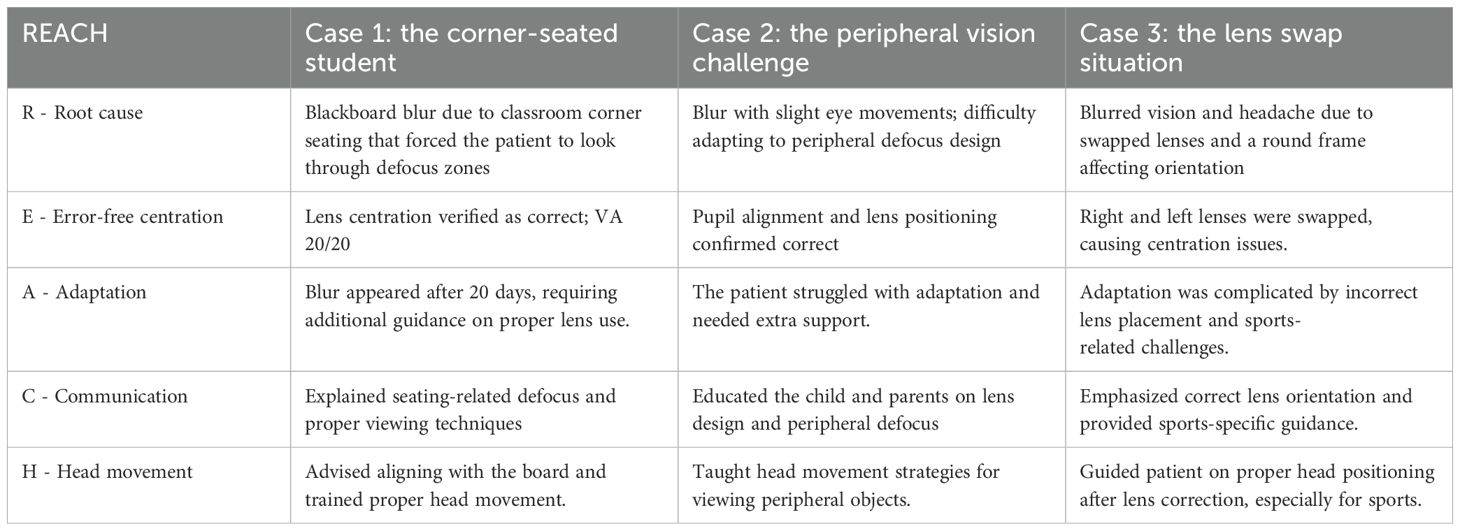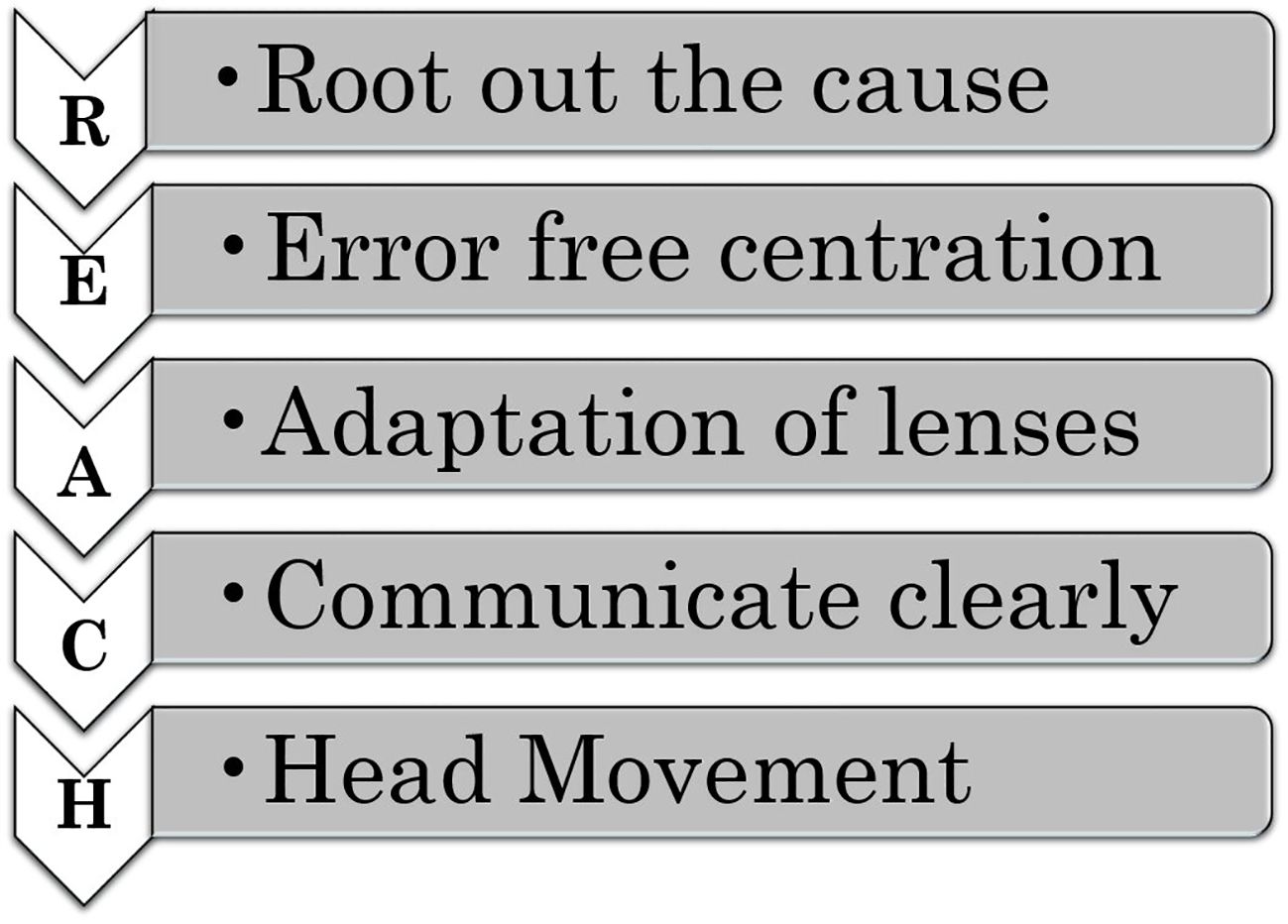- Infor Myopia Centre and Myopia Research Lab, Brien Holden Institute of Optometry and Vision Sciences, Prof. Brien Holden Eye Research Centre, L V Prasad Eye Institute, Hyderabad, India
Letter to the editor
The worldwide increasing trend in the prevalence of myopia and its associated complications has led to the development of various optical solutions for controlling myopia progression in the last decade (1).
With research highlighting the importance of counteracting peripheral hyperopic defocus (2), myopia control peripheral plus or defocus spectacle lenses have been made commercially available in multiple countries. These spectacles incorporate a central distance clear zone with plus power in the peripheral regions, creating a peripheral myopic defocus that is hypothesized to slow down the axial elongation. Although these lenses have demonstrated good treatment efficacy (2, 3), a certain proportion (albeit small) of children may experience or complain about visual disturbances with these spectacles despite achieving 20/20 central visual acuity for distance viewing at the time of prescribing. It is important that the quality of vision is not altered and there are no issues with the spectacles to achieve the best compliance and successful outcomes. However, the nature of the design of these spectacles is likely to influence visual performance in the initial days of lens wear. For example, a questionnaire-based study conducted in Chinese children demonstrated that the children had reduced mid-peripheral vision through the lenses compared with single-vision lenses (4).
These spectacles are relatively new to the ophthalmic clinical practice, and they present unique issues for the patients and practitioners that warrant the attention of stakeholders, especially for troubleshooting. Based on clinical experience in myopia management, we present a troubleshooting guide with the acronym “REACH” to address visual disturbances in children wearing peripheral defocus spectacles as indicated in Figure 1. This guide includes key aspects of patient-parent communication and strategies for managing concerns, illustrated through three real patient cases as indicated in Table 1. The insights a practitioner gets through REACH are critical to ensuring the success of myopia management, which can be seen below.

Table 1. Example cases where troubleshooting of peripheral defocus myopia control spectacles was conducted using the REACH guidelines.
R: Root out the cause
In clinical practice, it is crucial to understand the child’s concerns and experiences after wearing myopia control spectacles in spite of having 20/20 visual acuity on examination. Thus, one must root out the cause of the problem with these lenses by engaging in open-ended discussion-driven conversations to uncover the underlying problem that may impact vision and, in turn, the compliance and the effectiveness of myopia control treatment. Regular follow-up visits after initiating treatment are therefore important to monitor the child’s visual comfort, assess treatment progress, and address any concerns promptly. This proactive approach ensures that necessary adjustments are made in a timely manner, fostering optimal treatment success and long-term visual health.
E: Error-free centration
It is essential to ensure that the clear central zone of the lens is properly aligned with the center of the pupil. Peripheral defocus spectacles from various companies have a central clear zone varying from 8 mm to 9.4 mm (2, 3, 5). Additionally, one should verify if there is any low riding of the frame on the nose such that the child is looking through the defocused zone, causing blurred vision. Larger frames with minimal pantoscopic tilt may help maintain the intended optical design and prevent unintended shifts in the defocus zone.
A: Adaptation of lenses
Given that these peripheral defocus lenses are different from conventional single vision lenses, it is important to indicate the need for adaptation time with these lenses of at least 2–3 weeks. For children sensitive to peripheral blur, it is important to take additional care when introducing myopia control spectacles. One should highlight that the child needs ample time for them to adjust to the new visual experience, especially if they previously struggled to adapt to changes in single-vision spectacles or returned to the clinic soon after trying peripheral defocus spectacles.
C: Communicate clearly
One should begin by explaining to both the child and their parents, in simple terms, how peripheral hyperopic blur works and its connection to myopia control spectacles. If possible, one should show them demonstration lenses and describe the design, nature, and purpose of these lenses, emphasizing how they help manage myopia and set the expectations upfront.
H. Head movement
One should encourage the child to adopt a head movement strategy instead of relying solely on eye movements to view objects outside the central clear zone. By turning their head to direct their gaze, they can bring the objects into the clear central zone and minimize peripheral blur. Otherwise, the child is likely to indicate a perception of blurring when viewing objects in the peripheral visual field. This is especially relevant in school when looking at a whiteboard or LED screen while sitting in a corner or on one side of the classroom.
Case 1
A 12-year-old with -3.50 DS refractive error in both eyes reported occasional blackboard blur after 20 days of wearing peripheral defocus spectacles. An investigation revealed the child’s habit of sitting in a corner of the classroom, which required him to look through the defocus zones and experience blur. As indicated in Figure 1, REACH we recommended a head movement strategy, being aligned with the board, and using head movements to view peripheral objects. In the subsequent follow-up, the child confirmed this adjustment resolved the issue completely.
Case 2
A 11-year-old with refractive error (RE: -2.50DS/-1.00DC×180, LE: -3.00DS/-1.00DC×180) returned to our clinic a month after starting to wear peripheral defocus spectacles, reporting blurred vision with slight eye movements. On examination, visual acuity was 20/20 in both eyes, indicating good central vision. After confirming proper pupil alignment within the clear zone, we educated the child and parents on the lens design, stressing the need for adaptation and head movements to view peripheral objects. In the subsequent follow-up, the child reported complete resolution of the issue, demonstrating the value of counseling and support.
Case 3
A 9-year-old with refractive error (BE: -4.00DS/-1.00DC×180 in both eyes) returned a month after being prescribed peripheral defocus spectacles, reporting blurred distance vision and frontal headache with no other ocular complaints. An examination showed a one-line reduction in vision despite the correct prescription. On further examination, the child was found to be wearing circular-shaped frames, and the issue was due to misaligned lens centration caused by swapping the right and left lenses in identical round frames. Adjusting the lenses resolved her symptoms.
Additionally, some children reported difficulties playing sports such as tennis and badminton with these spectacles, underscoring the importance of addressing individual needs and offering tailored guidance. Based on our experience, young adults who are likely to drive also expressed some level of discomfort with the defocus spectacles.
REACH can act as a guideline to prevent any complications or for troubleshooting, given that the complaints are multi-dimensional. It would be useful for a clinician to have a checklist in the form of a structured questionnaire to enhance the evaluation of the patient’s experience and discomfort.
Conclusion
The REACH troubleshooting guidelines will benefit eye care practitioners when prescribing peripheral defocus spectacles for myopia control. These guidelines can help eye care practitioners to reduce multiple clinic visits, dropouts, and issues related to poor compliance when peripheral defocus spectacles are prescribed.
Author contributions
GM: Writing – original draft, Conceptualization. SS: Writing – original draft, Conceptualization, Writing – review & editing. PV: Supervision, Writing – review & editing, Conceptualization, Resources.
Funding
The author(s) declare that financial support was received for the research and/or publication of this article. Supported by Hyderabad Eye Research Foundation.
Conflict of interest
The authors declare that the research was conducted in the absence of any commercial or financial relationships that could be construed as a potential conflict of interest.
Generative AI statement
The author(s) declare that no Generative AI was used in the creation of this manuscript.
Publisher’s note
All claims expressed in this article are solely those of the authors and do not necessarily represent those of their affiliated organizations, or those of the publisher, the editors and the reviewers. Any product that may be evaluated in this article, or claim that may be made by its manufacturer, is not guaranteed or endorsed by the publisher.
References
1. Holden BA, Fricke TR, Wilson DA, Jong M, Naidoo KS, Sankaridurg P, et al. Global prevalence of myopia and high myopia and temporal trends from 2000 through 2050. Ophthalmology. (2016) 123:1036–42. doi: 10.1016/j.ophtha.2016.01.006
2. Lam CSY, Tang WC, Tse DY, Lee RPK, Chun RKM, Hasegawa K, et al. Defocus Incorporated Multiple Segments (DIMS) spectacle lenses slow myopia progression: a 2-year randomised clinical trial. Br J Ophthalmol. (2020) 104:363–8. doi: 10.1136/bjophthalmol-2018-313739
3. Bao J, Huang Y, Li X, Yang A, Zhou F, Wu J, et al. Spectacle lenses with aspherical lenslets for myopia control vs single-vision spectacle lenses: A randomized clinical trial. JAMA Ophthalmol. (2022) 140:472–8. doi: 10.1001/jamaophthalmol.2022.0401
4. Lu Y, Lin Z, Wen L, Gao W, Pan L, Li X, et al. The adaptation and acceptance of defocus incorporated multiple segment lens for chinese children. Am J Ophthalmol. (2020) 211:207–16. doi: 10.1016/j.ajo.2019.12.002
Keywords: peripheral defocus spectacles, myopia control, counseling, education, troubleshooting
Citation: Shah S, Motwani G and Verkicharla PK (2025) “REACH’’ for troubleshooting peripheral defocus myopia control spectacles. Front. Ophthalmol. 5:1583599. doi: 10.3389/fopht.2025.1583599
Received: 26 February 2025; Accepted: 15 April 2025;
Published: 15 May 2025.
Edited by:
Meghal Gagrani, University of Pittsburgh, United StatesReviewed by:
Mukharram M. Bikbov, Ufa Eye Research Institute, RussiaCopyright © 2025 Shah, Motwani and Verkicharla. This is an open-access article distributed under the terms of the Creative Commons Attribution License (CC BY). The use, distribution or reproduction in other forums is permitted, provided the original author(s) and the copyright owner(s) are credited and that the original publication in this journal is cited, in accordance with accepted academic practice. No use, distribution or reproduction is permitted which does not comply with these terms.
*Correspondence: Pavan K. Verkicharla, cGF2YW52ZXJraWNoYXJsYUBsdnBlaS5vcmc=
†These authors have contributed equally to this work and share first authorship
 Sujit Shah†
Sujit Shah† Pavan K. Verkicharla
Pavan K. Verkicharla